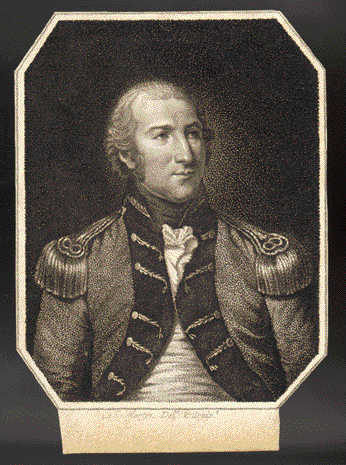Town Major Sirr, the arresting officer
Published in 18th–19th - Century History, Early Modern History (1500–1700), Features, Issue 3 (Autumn 2003), The United Irishmen, Volume 11
Major Henry Charles Sirr, Dublin’s de facto chief-of-police, by J. Martyn. (National Library of Ireland)
Robert Emmet was arrested on 25 August 1803 by Dublin’s chief of police, Town Major Henry Charles Sirr. From the time of his appointment as assistant town major in 1796 until his retirement to the police magistrates’ bench in 1808, Sirr created an era of surveillance, pursuit, detection and arrest that is probably unparalleled since that time.
On 12 March 1798 he arrested nearly every one of the United Irish Leinster provincial committee, in one swoop, at Oliver Bond’s warehouse, opposite the Brazen Head tavern. A violent and bloody struggle on a landing in a house on Thomas Street on the evening of 19 May ended with Sirr shooting and capturing the United army’s commander-in-chief, Lord Edward Fitzgerald, a former brother officer and acquaintance since meeting years before in the garrison at Gibraltar. Days later he arrested the Sheares brothers—Henry at his house on Baggot Street, and John at Surgeon Lawless’s house.
Born in Dublin in November 1764, Sirr spent much of his early life at the family home on the corner of Golden Lane and Bride Street. His was a military family, and he went on to serve in the 68th Regiment of Foot, serving in Munster and Gibraltar, gaining the rank of captain, and acting as ADC to Governor Eliott, his uncle, on the Rock. He married Elizabeth D’Arcy of Killucan, Westmeath, at St Mary’s Church, Mary Street, on 12 August 1791 and settled into married life and business as a wholesale wine merchant at 35 French Street (now Upper Mercer Street). The Merchant’s Guild elected him to serve on the common council of Dublin Corporation. In 1796 Sirr joined, and immediately became adjutant to, the Stephen’s Green company of the First Regiment of Royal Dublin Volunteers (later to evolve into the Dublin Fusiliers). In November of that year he was appointed acting town major, and in 1798 he received his full commission from the king and strode into our history books.
Sirr, with a reduced police force and pathetic watch system, performed astonishing acts of skill and bravery, and had a seemingly uncanny ability to appear at two places almost simultaneously. He escaped at least three assassination attempts. Zealously collecting all doggerel, rhyme and cartoons against himself, he became a police magistrate in 1808 and eased into contented half-retirement, living with his wife and four children at Cullenswood, Ranelagh. Dispensing tongue-lashings and fines at his unique early-morning courts, he sent the chastened ones away in time for work at bench or market stall. His leisure time was devoted to family, charities, and to increasing his collection of curios and antiquities, many of which are now in our National Museum.
He died in his rooms in Dublin Castle on 7 January 1841. He lies in St Werburgh’s, in a family grave, close to the vault of fellow soldier, United leader and famous captive, Lord Edward Fitzgerald.
Pat Marshall is a Dublin local historian.
















